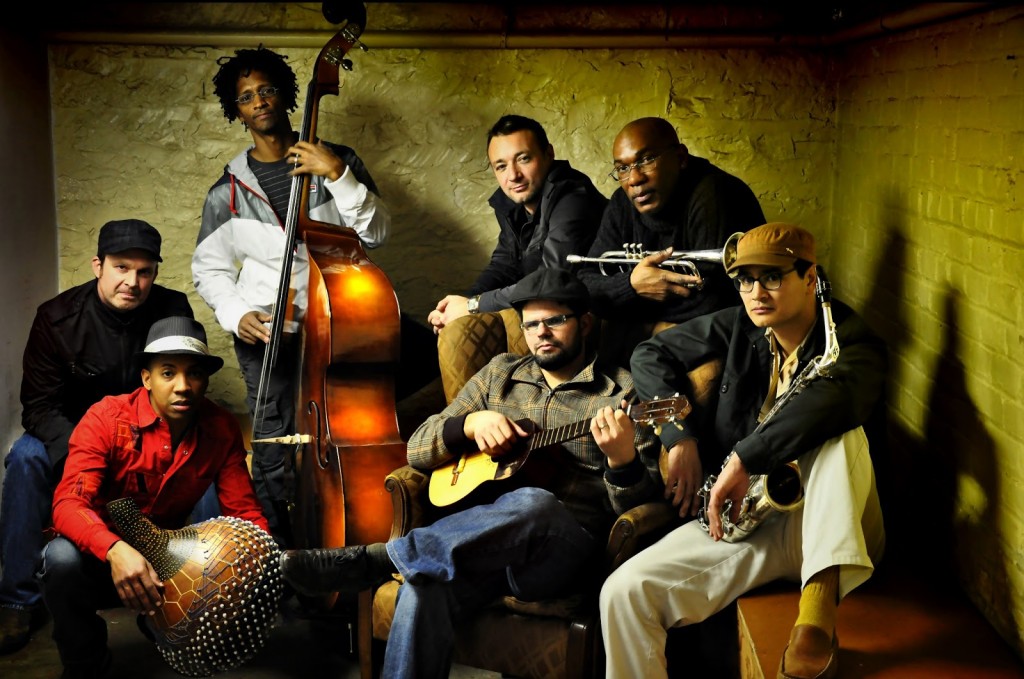World Music Interview: Kobo Town — Playing the Calypso News
NOTE: KOBO TOWN’S PERFORMANCE AT JOHNNY D’S HAS BEEN CANCELLED
By Noah Schaffer
Go almost anywhere in the world, and you’ll find a local reggae band. But calypso, the music from Jamaica’s neighbor Trinidad and Tobago (T&T), is a much rarer bird. Even in T&T the pointed storytelling and political commentary associated with calypso is fast being replaced by the non-stop party sounds of soca.
But at least one young artist is keeping the art of calypso alive: Trinidadian-Canadian Drew Gonsalves, founder of the band Kobo Town. The group, which makes its Boston debut at Johnny D’s this Tuesday (July 16), infuses the wit and wisdom of calypso lyrics with an appealingly original, acoustic Afro-dubwise sound. It’s most recent release, “Jumbie in the Jukebox,” celebrates the Caribbean music tradition of instant musical commentaries: it is an ode to the editorials that used to be found in the “Kaiso Newscast,” which took aim at tourists who only wanted to see “Postcard Poverty.”
Recently I spoke to Gonsalves about the group and the future of calypso via telephone from his Toronto home.
Arts Fuse: Why is calypso such a neglected musical form, compared to reggae, which is so universally celebrated?
Gonsalves: The case of reggae is unique—you have to look at the time in which it spread. Reggae comes out of a specific social movement in the Jamaican urban underclass: the Rastafarian ideology, which was an ideology of rebellion. That resonated around the world with hippies, punks, and disaffected youth. It appealed to a larger culture of rebellion. Calypso has a more complicated history. It’s not product of a single class of people, it’s a product of an island that has a history of being populated by people from a number of backgrounds, all of which have added something to this music. In a way, it’s a genuine folkloric music: it’s the music of the folks, and it contains a wide variety of views. There can be a calypso from every single side of an issue.
Arts Fuse: Speaking of the many sources on which calypso draws, you play the cuatro, the string instrument most commonly associated with traditional Puerto Rican and Central American music. But it’s also been a big part of Trinidadian music—for instance it’s heard every Christmas in parang songs.
Gonsalves: The cuatro was staple of calypso in its early years, and it is still a stable of parang. Whether it came from the indigenous Spanish population or the migrants from Venezuela who arrived in big numbers in the early 1900s is not known, but the scratchy sound of cuatro was a big part of Caribbean folk musics. Calypso reflects a marriage of the African and Creole culture that came via the French Caribbean, which, when mixed with European elements, evolved in new directions.
Arts Fuse: Your sound pays homage to the calypso tradition, but musically you depart from the classic big band sound heard on the most famous calypso recordings. It seems like you’re trying to be something other than a revival band.
Gonsalves: I’m often asked whether I’m trying to preserve or revive calypso, and my honest answer is a bit confusing. I’m not sure I set out to do anything. I’m an undisciplined songwriter, and I write whatever comes to me, and this is what comes to me. So the music reflects my wider life experience of being an outsider/insider. I’ve lived away from Trinidad for so long, and I’m interested in so many other types of music, that I can’t help but write with all these other [musical elements] in the back of my mind. Our drummer is a rocker, you’ll hear that in his songs, he’s a heavy hitter and a lot of our powerful drive comes from that attitude.
Arts Fuse: It’s not uncommon to read articles in the Trinidadian press bemoaning how few younger artists are carrying forward the calypso sound. Have they embraced you?
Gonsalves: The Trinidadian press has been really supportive—every now and then someone back home sends me clippings of an article. . . . it’s not the mainstream attention a big soca artist would get, but we have a small but very loyal following, and some of the most touching encouragement has come from people in Trinidad.
Arts Fuse: Although calypso is not as big as soca, calypso concerts and record shops can be found in New York, and the music can be heard live and on the radio in Boston, Toronto, and London. Do you think the music is bigger in the diaspora where it expresses cultural identity?
Gonsalves: Yes, this is true in some ways. But the calypso diaspora struggles with same thing in Trinidad, which is that it’s become a seasonal music. This is not a recent phenomenon. The music is centered around the calypso monarch competitions, which take place during Carnival. I’m really glad these competitions provide the impetus for the music and help preserve the art and help it survive, but the seasonal nature of it is a bit of a cage. Calypso used to be immediately responsive: when there was a scandal in the Treasury, there was a calypso. When Italy invaded Ethiopia, there was a calypso. I would love to see calypso recover some of that urgency again, both in Trinidad and everywhere else that calypso is played.
Tagged: Caribbean, Drew Gonsalves, Jumble in the Jukebox, calypso


